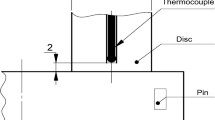Abstract
This study used a dedicated wear tester to verify the cause and amount of wear depending on fuel type such as LPG and gasoline. Test conditions for general commercial vehicles, such as number of cycles (2 × 106), test speed (25Hz), temperature (350°C), and force (1960N) were applied to the specimens. This study utilized LPG and gasoline as test fuels. The maximum depth of wear (Dmax) of the exhaust valve and the seat insert was 74.7 (± 3.9)μm and 82.9 (± 2.9)μm, respectively, in the case of the test using LPG, and 64.6 (± 4.0)μm and 59.4 (± 1.2)μm, respectively, in the case of the test using gasoline. The result of the analysis performed on the compositions of the combustion products appearing on the exhaust valve and the seat insert using EDS (Energy Dispersive Spectroscopy) indicated that, in the case of the test performed with LPG, O and S were detected from the test specimen, and that in the case of the test specimen performed with gasoline, O, P, and Ca were detected from the test specimen. The analysis results from the composition of the seating faces indicated that the seating face of the exhaust valve had Cu and Mo existing only in the seat insert regardless of the type of fuel used. In addition, Si and Mn, which existed only in the exhaust valve, were detected in the seating face of the seat insert. The mean Dmax of the exhaust valve and the seat insert, for which the test was performed with LPG fuel, was greater than that of the exhaust valve and the seat insert for which the test was performed with gasoline fuel, 14.5% and 29.4%, respectively. The adhesive wear and tribochemical reaction products were observed regardless as to whether the fuel type was LPG or gasoline. However, the abrasive wear was observed only at the seating face of the seat insert for which the test was performed with LPG fuel. From the analysis performed based on the above results, it is thought that since LPG fuel has less combustion products that act as a gum component that lubricates the valve and the seat insert seating faces than gasoline fuel. The direct metal-to-metal collision between the valve and the seat insert seating faces may generate more particles with LPG fuel. Therefore, The abrasive wear was observed only in the specimen for the test performed with LPG fuel, however it was not observed in the specimen for the test performed with gasoline fuel.
Similar content being viewed by others
References
Wang, Y. S., Narasimhan, S., Larson, J. M., Larson, J. E. and Barber, G. C., “The effect of operating conditions on heavy duty engine valve and seat wear,” Wear, Vol. 201, No. 1–2, pp. 15–25, 1996.
Malatesta, M. J., Barber, G. C., Larson, J. M. and Narasimhan, S. L., “Development of a Laboratory Bench Test to Simulate Seat Wear of Engine Poppet Valves,” Tribology Transactions, Vol. 36, No. 4, pp. 627–632, 1993.
Lewis, R., Dwyer-Joyce, R. S. and Josey, G., “Investigation of Wear Mechanisms Occurring in Passenger Car Diesel Engine Inlet Valves and Sear Inserts,” SAE Paper, No. 1999-01-1216, 1999.
Chun, K. J., Hong, J. S. and Lee, H. J., “A Study on Engine Valve and Seat Insert Wearing Depending on Speed Change,” SAE Paper, No. 2004-01-1655, 2004.
Giles, W., “Valve Problems with Lead Free Gasoline,” SAE Paper, No. 710368, 1971.
Chun, K. J., Kim, J. H. and Hong, J. S., “A study of exhaust valve and seat insert wear depending on cycle numbers,” Wear, Vol. 263, No. 7–12, pp. 1147–1157, 2007.
Zhao, R., Barber, G. C., Wang, Y. S. and Larson, J. E., “Wear Mechanism Analysis of Engine Exhaust Valve Seats with a Laboratory Simulator,” Tribology Transactions, Vol. 40, No. 2, pp. 209–218, 1997.
Slatter, T., Taylor, H., Lewis, R. and King, P., “The influence of laser hardening on wear in the valve and valve seat contact,” Wear, Vol. 267, No. 5–8, pp. 797–806, 2009.
Chun, K. J. and Hong, J. S., “Engine Valve and Seat Insert Wear Depending on Speed Changes,” JAUTO, Vol. 219, No. 4, pp. 525–534, 2005.
Lewis, R., Dwyer-Joyce, R. S. and Josey, G., “Design and Development of a Bench Test-Rig for Investigation Diesel Engine Inlet Valve and Seat Inset Wear,” Proceedings of the 5th International Tribology Conference, pp. 365–370, 1998.
Pyle, W. R. and Smrcka, N. R., “The Effect of Lubricating Oil Additives on Valve Recession in Stationary Gaseous-Fueled Four-Cycle Engine,” SAE Paper, No. 932780, 1993.
Kimihiko, A., Akira, M. and Akio, Y., “Hardfaced Valve and P/M Valve Seat System for CNG and LPG Fuel Engines,” SAE Paper, No. 2005-01-0718, 2005.
Godfrey, D. and Courtney, R. L., “Investigation of the Mechanism of Exhaust Valve Seat Wear in Engines Run on Unleaded Gasoline,” SAE Paper, No. 710356, 1971.
Matsushima, N., “Powder Metal Seat Inserts,” Nainen Kikan, Vol. 26, No. 1–2, pp. 52–57, 1987.
Giles, W. S. and Updike, S. H., “Influence of Low Lead Fuels on Exhaust Valve Performance,” SAE Paper, No. 710674, 1971.
Sato, K., Midorikawa, T., Takahashi, T. and Oshige, H., “Development of Valve Seat Material for Gas-Fueled Engines,” SAE Paper, No. 2000-01-0911, 2000.
Author information
Authors and Affiliations
Corresponding author
Rights and permissions
About this article
Cite this article
Hong, J.S., Kim, Y.S. & Chun, K.J. Study on exhaust valve and seat insert wear depending on fuel type. Int. J. Precis. Eng. Manuf. 13, 253–260 (2012). https://doi.org/10.1007/s12541-012-0031-5
Received:
Accepted:
Published:
Issue Date:
DOI: https://doi.org/10.1007/s12541-012-0031-5




